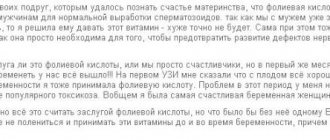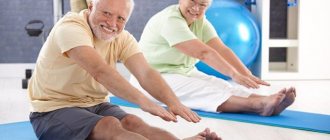“Birch” is an exercise familiar from school physical education lessons. The position is used during intercourse of partners. This body position helps the man penetrate deeper into the woman’s vagina; the head of the penis is as close as possible to the cervix, which increases the percentage of sperm entering the uterus and retaining them.
Why can't you conceive a child?
Why can't I get pregnant? Perhaps the problem is that your reproductive system has failed somewhere. Maybe it's due to inflammatory processes in the genitourinary system or a problem with hormonal imbalance.
Irregular menstruation, stress, poor environment, long-term antibiotic therapy, poor diet, etc. – There can be many reasons for the absence of pregnancy during regular sexual activity. As a rule, they can be easily identified by a thorough medical examination.
Keep in mind that more than a third of married couples do not have children because of the “female” factor. A man should also undergo examination, because the problem of male infertility often occurs.
By the way, at family planning centers men are checked first. After all, male infertility (inability to have children) is much easier to identify than female infertility - usually a spermogram is sufficient.
But what to do if all the tests are normal, periods come exactly on time, ovulation is regular, and both partners are generally healthy? Or maybe it’s time to add elements of simple acrobatics to intimacy?
Common mistakes
For beginners, at first it is a problem to keep their legs upright - they often lean forward and create additional pressure on the chest. In this case, it is better to simplify the task by doing everything with your feet resting against the wall or with a chair.
Surely each of us remembers how in school during physical education we were taught to do the “birch tree” exercise, the benefits and harms of which we did not think about at all in those years.
In fact, “the pose of all parts of the body,” “candle” or sarvangasana, as it is also called, is considered a real elixir of youth and beauty. Regularly performing this stance for a couple of minutes a day can work real miracles with our body. You will learn about the benefits of the “birch tree” exercise from this article.
The benefits and harms of the “birch tree” exercise
Ideally, this is a pose in which the back of the head, shoulders and neck are on the floor, and the rest of the body is level and vertical. Thus, most of the muscles are involved in the process.
The main benefit of the birch exercise is its beneficial effect on the functioning of the heart and strengthening the muscle itself, namely the left ventricle. In addition, sarvangasana helps get rid of circulatory disorders in the brain. Due to the inverted position of the body, blood flow to the occipital part of the head increases through the vertebral artery. This helps get rid of headaches, improves the color of the skin of the face and neck, relieves fatigue and helps prevent thyroid diseases.
The great benefits of the “birch tree” exercise are manifested in improving the health of the back. This body position strengthens the upper torso muscles, improves the flexibility of the spine, which ensures the health of all internal organs. Performing a “candle” for 1 - 2 minutes a day helps eliminate diseases of the pelvic organs, prevent constipation, digestive problems and curvature of the spine. To lose weight, it is important to perform the “birch tree” exercise regularly. Since this position of the body helps to flatten the stomach and toxins, eliminate salt deposits, relieve pressure on the abdominal cavity and improve intestinal function, weight loss will occur faster and more effectively.
Acute contraindications to the “birch tree” exercise include the presence of an inguinal hernia. It is also undesirable to perform sarvngasana during menstruation and on “cold” muscles.
How does it help you get pregnant?
“Birch” is an exercise everyone is familiar with from school physical education lessons. How does it promote fertilization? The physiology of conception is simple: for the birth of a new life, it is necessary that an egg ready for fertilization and a healthy active sperm meet in the fallopian tube.
However, despite all the simplicity, there are many difficulties. For example, in order for conception to occur, one single sperm out of about 10 million must penetrate not only the egg, but also overcome a rather difficult path through the acidic environment of the vagina, through the viscous cervical mucus, through the entire fallopian tube.
The female reproductive system is designed in such a way that the fallopian tubes are located much higher than the entrance to the vagina, so the sperm also have to “fight” gravity: most of the sperm simply flows out of the vagina. This is why it is commonly believed that the birch tree pose can help.
Movement of sperm before conception
In order to understand how fertilization of an egg occurs, it is necessary to study a little deeper the physics of sperm movement.
Everyone knows that the sperm has the shape of a “tadpole”, and its movement towards the egg occurs due to a kind of “tail” or flagellum. It makes wave-like movements and rotates around its axis, thus reaching maximum speed.
Sperm have a difficult journey through the vagina, cervix, uterus and fallopian tube.
The uterine cavity is about 5 cm, the cervical canal is another 2 cm, and the fallopian tube is approximately 12 cm: thus, the sperm needs to travel a distance of at least 20 cm.
Considering that the size of the sperm itself is measured in thousandths of a centimeter, then this is a decent distance.
However, fast sperm, provided that they maintain mobility within the normal range of a healthy person, travel this path and reach their goal in 1-2 hours.
After this, the sperm takes a wait-and-see position in the fallopian tube. This factor explains that 4 days before ovulation and the day after are favorable for conception. The sperm remains active all this time and, being in the fallopian tube, is ready to fertilize the egg at any time.
The benefits of "birch"
Remember what this pose represents? You stand on your shoulder blades, supported by your forearms, with your pelvis positioned above the shoulder girdle and head, your legs extended vertically upward, and your arms bent at the elbows at an angle of approximately 45 degrees and supporting the body. Like in this photo.
Alas, not everyone succeeds in making a “birch tree” the first time, but patience and regular training quickly prepare the body for this position, and many are able to maintain the pose for quite a long time. By the way, in yoga, a similar pose is a variant of an inverted asana and solves a number of health problems:
- improves cerebral circulation;
- strengthens the spine;
- helps improve kidney function;
- prevents constipation, etc.
But what is good about this position for conception?
Correct technique and types
I will give several options for the correct technique of the classic and lightweight versions of the “birch tree”.
Classic "birch"
To begin with, it doesn’t hurt to prepare a place for training. Place a blanket folded in four on the floor. Lie down so that your head is on the floor and your shoulder blades are at the very edge of the mat.
- Lie on your back and make sure your feet touch each other. Strain your knees and stretch your arms along your body. Palms face down, neck and head are in line with the spine.
- As you exhale, raise both legs together, bringing them to a right angle with the body. Toes point up. Let's breathe calmly.
- As you exhale, raise your legs higher by lifting your hips and back from the surface. Support your lower back with your palms.
- Now we pull our legs even higher and bring them in line with the buttocks. Pull your back, buttocks and waist inward so that your torso is perpendicular to the ground.
- While breathing normally, we hold this position for some time.
- We exhale, release our arms, and gradually slide down until our back rests on the floor and our legs take a position perpendicular to the floor. We lower them to the floor.
Wall supported
- Place the blanket 60 centimeters from the wall. We lie on our backs, making sure that our shoulders are positioned on the mat 3 cm from its edge, and our heads are on the floor.
- Bend your knees and stretch your arms out at your sides, palms up.
- We press the back of our head to the floor, and our arms and shoulders to the blanket. As you exhale, move your legs behind your head and touch the wall with your toes. Bend your elbows and place your palms under your lower back (fingers pointing up).
Option with a chair
In addition to the chair, we will need a bolster. We place it on the ground, parallel to the front legs of the chair. chest to the back, clasping it with your arms. Alternately, we throw our legs over the back and slowly lower our arms, moving ourselves closer to it with our buttocks.
- We lower our backs to the level of the seat and rest our elbows on it. Hold on to the back and move your buttocks closer to the front edge of the seat. We lower our shoulders onto the bolster, carefully sliding out of the seat. Place the head on the surface. We grab the back legs with our hands and straighten our legs.
- We hold this position for some time. We take our hands to the side edges of the chair (closer to its back). Bend your knees and place your feet on the upper part of the backrest. The buttocks lie on the front edge of the seat.
- Supporting the body with your hands, straighten your legs one by one. Raise the chest as high as possible. We stay in this position for some time.
- As you exhale, lower your feet onto the back and slowly slide out of the seat.
When performing, you should control the position of your elbows - they should not be wider than your shoulders. As you lift your lower body upward, make sure your upper chest touches your chin. In this case, the larynx should not be compressed. The appearance of a cough at this moment or when lowering the body indicates a constricted throat.
What time of day should you do the exercise?
How long do you need to stand?
It all depends on personal feelings. At first, you simply won’t be able to maintain such a specific position for long. It is better to start with one minute, gradually increasing the time to 5 minutes.
Sets and reps
"Birch" during sex...
Some experts recommend using the “birch tree” as a position for intercourse. The fact is that in this position, the cervix is as close as possible to the head of the penis, and with such deep penetration, the number of sperm penetrating into the uterus and beyond increases.
But the problem is that a woman who is untrained and far from yoga and gymnastics cannot stand in such a pose for a long time. And it is difficult for a man to “fit in” with a woman who is trying to stand upside down.
Therefore, if you are not a circus performer, you can use other positions for conception.
Contraindications
Since this is an inverted asana, it is contraindicated in cases of severe hypertension. If we are talking about its mild forms, then you can practice it with extreme caution and in consultation with your doctor. Other restrictions and contraindications to performing the pose include:
- Heart diseases.
- Atherosclerosis.
- Previous spinal injuries and severe spinal and neck pain.
- Hyperfunction of the thyroid gland (hyperthyroidism).
- The period of menstruation and pregnancy (especially the first trimester).
- Epilepsy.
- Otitis and sinusitis in the acute stage.
- Retinal diseases and glaucoma.
…and after
There is another use of the “birch tree” to stimulate conception - standing on the shoulder blades immediately after unprotected sexual intercourse. This allows the sperm to continue their “journey” with minimal obstacles. The cervix in this position is located below the entrance to the vagina, the sperm does not flow out, but lingers inside for a long time, and the sperm manage to penetrate through the cervical canal.
There is no clear opinion on how long you should stand upside down. Some say 15-30 minutes. But for most this is unrealistically high, so stand as long as you can. You can even lean your feet against the wall.
In this case, the rule must be observed: no shower before the “birch”, otherwise some of the sperm will simply flow out on the way to the bathroom, and some will be washed away when washing.
However, you must be aware that this method is just a small physiological aid to the fertilization process, but not a panacea for serious health problems! If the “birch tree” solved all issues related to infertility, then such a line of people desperate to become parents would not stand at the reproductive specialist’s office.
Useful tips for patients
It is better to perform the “Birch” exercise in the morning and on an empty stomach. If this is not possible, then you should reschedule the lesson for the evening, 2 hours before going to bed. But in this case, the last meal should be taken 3 hours before the start of the workout.
You shouldn’t immediately move on to “Berezka” during class. Women should perform the exercise at the very end, when the muscles are well warmed up. If the workout consists of this one pose, then you must do a warm-up before it. Otherwise, it will do more harm than good. All movements must be carried out smoothly, without jerking or strong tension.
When standing, pay attention to your elbows. They should be as close to each other as possible. And the shoulders should be pulled further away from the ears. While performing the asana, you need to keep your feet together.
If you feel discomfort in the head and neck, there is a cough or there is pressure in the throat, it means that the exercise is not being performed correctly , and the entire body weight is not transferred to the shoulders.
To avoid this situation, beginners are advised to use a blanket. It should be folded in four and then placed under you so that during the pose the shoulder blades are located on the edge of the material and the head lies on the floor. If one blanket is not enough, then you need to add one or two more.
The time it takes to perform “Berezka” depends on your physical fitness. But for beginners, it is recommended to hold the pose for 30 seconds at first. And then you need to gradually increase the duration of the workout, for example, adding 2 seconds a day.
If there is the slightest pain in the lower back or neck, you need to immediately get out of the pose, but this must be done smoothly.
Arguments against
Not all doctors agree that this position can affect conception. Many gynecologists believe that this is a myth. After all, sperm are “programmed” to rush to where they need to be for fertilization. And they don’t need any additional “crutches” - they themselves know what to do.
During PA, millions of “tailed animals” enter the uterus. And even if many get lost, a whole army of sperm will still reach the goal. Therefore, a healthy body can cope on its own, without special poses.
Competently: the opinion of a gynecologist
Obstetrician-gynecologist Elena Artemyeva answers patient questions
- We want a child. We read that you can get pregnant by injecting sperm into the vagina with a syringe. We tried twice, but the sperm leaked out.
- Do not experiment with a syringe, it is unnatural and does not promote conception. It’s better to stand in the “birch tree” position after PA and don’t wash yourself for two hours. Fertile days are from 5 to 14.
- My neck is bent backwards. The doctor said that this makes it difficult to conceive. And she recommended the “birch tree” pose after contact. Will this help?
- Yes, sometimes this position after coitus helps sperm penetrate the uterus.
Sometimes, in order to get pregnant, you need to put in a lot of effort and resort to using postures for favorable conception. Of course, every woman’s body is individual, but there are still ways that can bring a couple closer to this long-awaited result. Let's look at the best positions to get pregnant.\r\n\r\nThe top position is the least suitable for this, because it promotes the flow of sperm out and also makes it difficult for them to reach their intended destination. The emphasis should be on positions in which sperm will easily enter the uterus, then fertilize the egg. The most win-win position is when the woman is on the bottom.\r\n\r\n \r\n
What to do if it doesn't work out
If it is not possible to stand in the “birch tree” after PA for a number of reasons, among which most often is the woman’s build (fullness), spinal diseases, or banal embarrassment in front of a partner, then it is enough to just lie quietly on your side or stomach for about half an hour.
So, is the birch tree position effective for conception? This method is successfully practiced by many women, but it has not been scientifically proven that the position “on the shoulder blades” is the cause of fertilization. Most likely, the couple simply managed to “catch” the time favorable for conception, and the “birch tree” only contributed to the penetration of sperm into the uterus.
However, there is no harm to the body from such help either, so why not experiment and at the same time become more flexible and resilient?
What is special about the pose?
Not every woman, due to numerous physiological reasons, can take this body position: stand in the “birch tree” pose. It happens that a partner does not feel comfortable positioning himself next to a woman standing upside down. Then you need to lie on your side or lie on your stomach after intercourse for 30 minutes. You can't get out of bed right away. You can also take a pose when the pelvis is higher than the position of the head. To consolidate the result, do not wash yourself after the act for two hours.
Additional options for conception positions:
- – the woman lies on her back, and the partner is on top;
- on the side - the man enters the partner from behind;
- “Dogi style” - the woman is on her knees, and .
The “cowgirl” position is considered unsuccessful when the partner is on top, because a lot of seminal material comes out of the vagina.
Several at a time!
So many parents want to do everything at once! In other words, they simply dream of having twins or even triplets. Is there a position for conceiving multiple children?
In this regard, doctors say that everything here is determined by the predisposition of both partners, and the chance of giving birth to twins or triplets is much higher for a couple whose families have ever had similar cases.
As for a certain position for conceiving two or more fetuses, doctors just shrug their shoulders, pointing out that such a position cannot be reliably named. Heredity and cell characteristics will still play a decisive role.









